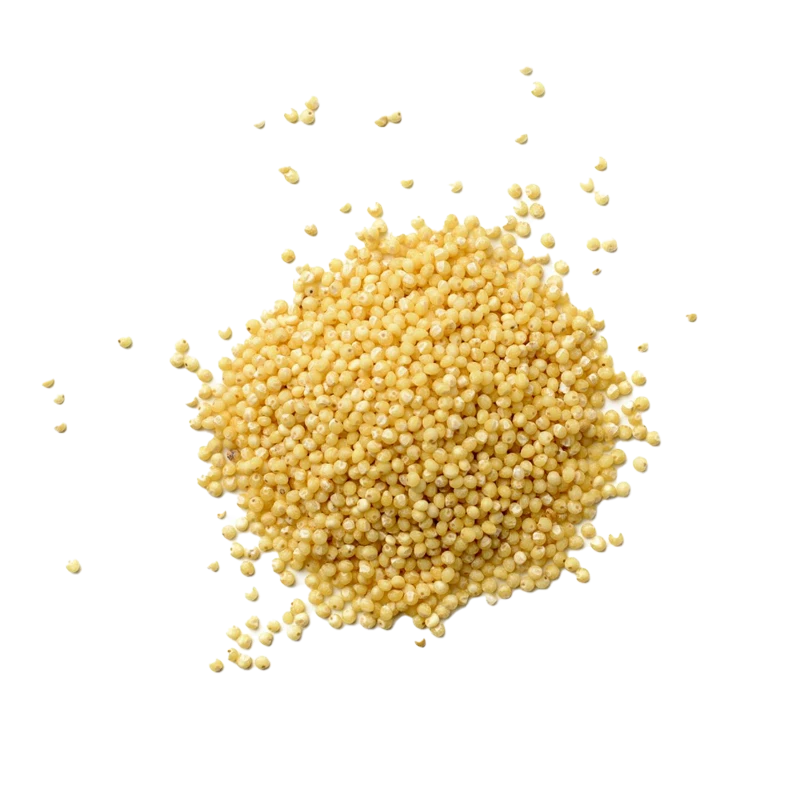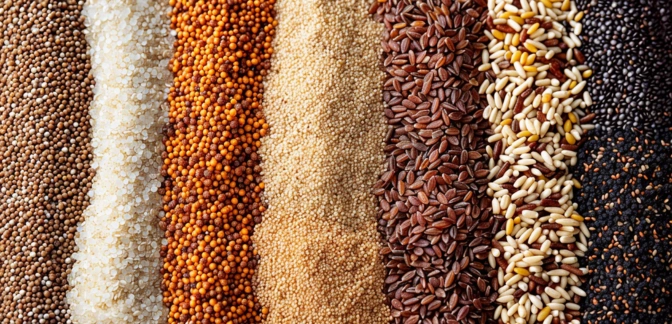Millet Groats — Nutrients, Health Benefits, and Shopping Tips

Written by Listonic Team
Last update on September 4, 2024
Nutrition facts
Nutrition facts
Amount per 100 g
Calories
🔥 360 kcal
| Nutrients per: 100 g | Value | % Daily Value* |
|---|---|---|
| Carbs | 73 g | 26.55% |
| Fiber | 9 g | 32.14% |
| Sugars | 0 g | - |
| Glycemic Index | 71 | - |
| Protein | 11 g | 22% |
| Sodium | 5 mg | 0.22% |
| Total Fat | 4 | 5.13% |
*The % of Daily Value (DV) tells you how much a nutrient in a serving of food contributes to a daily diet. 2,000 calories a day is used for general nutrition advice.
11 g
🧀 Good Protein Content
9 g
🥔 Good Fiber Content
Did you know?
Health benefits
- High in protein for a grain, supporting muscle growth, repair, and overall body function.
- Rich in fiber, promoting digestive health, regular bowel movements, and a healthy gut microbiome.
- Gluten-free, making it suitable for individuals with celiac disease or gluten intolerance.
- Contains essential vitamins and minerals such as magnesium, phosphorus, manganese, and B vitamins, which support overall health and well-being.
- Low glycemic index, helping to regulate blood sugar levels and providing sustained energy.
Health risks
- Potential for digestive discomfort such as bloating or gas when consumed in large quantities due to their high fiber content.
- Anti-nutrient content such as phytic acid, which can inhibit the absorption of certain minerals like iron and zinc, though this is generally only a concern with very high consumption.
- Potential for goitrogens substances in millet that can interfere with thyroid function when consumed in very large amounts, especially in individuals with existing thyroid issues.
- Risk of contamination with pesticides or harmful bacteria if not properly sourced or stored.
How to choose millet groats
Millet groats should appear round and golden, with a slight shine that indicates they are unspoiled and properly dried. The texture should be firm, and they should cook up fluffy and light, not mushy or clumpy.
Steer clear of millet that smells musty or looks damp, as this can suggest improper storage. Well-cooked millet should have a mild, nutty flavor, making it an excellent base for pilafs or as a healthy grain alternative in salads.

How to store millet groats
Millet groats should be stored in an airtight container in a cool, dark place. A pantry or cupboard is ideal for maintaining their freshness. Properly stored millet groats can last for up to a year.
Humidity and exposure to air can cause millet groats to spoil. Avoid storing them in clear containers exposed to light, as this can degrade their quality. Always keep the container tightly sealed and store in a dry place to ensure longevity.
✅ Extra Tip
How long do they last?
Millet groats can last for 6-12 months when stored in an airtight container in a cool, dark place. For longer storage, they can be refrigerated or frozen, where they can last up to 1-2 years.
What to do with leftovers?
Leftover millet groats can be used in a variety of healthy and hearty dishes. Cook them and serve as a base for grain bowls with vegetables, beans, and a protein of your choice, or mix them into a salad with fresh herbs, nuts, and a tangy vinaigrette. Millet groats are also great when added to soups or stews for added texture and nutrition.
Use millet groats as a substitute for rice or quinoa in stuffed vegetables like peppers or tomatoes, or mix them into a casserole with cheese, vegetables, and herbs. If you have a lot of millet groats, consider making a batch of millet porridge with milk, honey, and fruits for a nutritious breakfast. Millet groats can also be used in baking, where they add a nutty flavor and crunchy texture to breads or muffins. For a quick snack, toast millet groats with nuts and seeds for a crunchy granola-like topping for yogurt or salads.
👨⚕️️ Medical disclaimer
How millet groats support specific health conditions
Millet groats are a gluten-free grain rich in fiber, promoting digestive health and helping with bowel regularity. They are also a good source of magnesium, supporting muscle health and heart health by regulating blood pressure. Millet groats provide plant-based protein, aiding in muscle health and tissue repair, and are rich in antioxidants, helping protect cells from oxidative stress. Their low glycemic index makes them ideal for blood sugar control.
Discover products from other categories
Listonic Team
Fact-checked
Our editorial team checked this article to make sure it was accurate at the time of publishing it.
Get the top-rated shopping list app

millet groats







